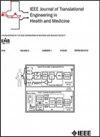Design and Validation of a Wearable System for Enhanced Monitoring of Lower Limb Lymphedema
IF 4.4
3区 医学
Q2 ENGINEERING, BIOMEDICAL
IEEE Journal of Translational Engineering in Health and Medicine-Jtehm
Pub Date : 2025-04-24
DOI:10.1109/JTEHM.2025.3563985
引用次数: 0
Abstract
Lymphedema, characterized by limb swelling, is typically treated with Complex Decongestive Therapy (CDT), which includes physical exercise. This study seeks to design and validate a wearable device aimed at enhancing CDT by monitoring patient adherence to prescribed exercises and tracking changes in the range of motion of the affected limbs. A wearable device, constituted by two boards with 2 IMUs, connected by a flexible flat cable, was designed and developed for placement across targeted joints. It communicates wirelessly with PCs, where raw data from IMUs are collected. Through the application of the Madgwick filter, orientation of the units is obtained and finally joints angles are computed. The device was validated through bench testing using an orthopedic goniometer and field testing with an optoelectronic system. The in vivo validation involved 18 volunteers, including 10 healthy individuals and 8 individuals with lymphedema, who performed flexion-extension movements and walked on a treadmill (at speeds of 3 km/h and 5 km/h). Bench testing demonstrated strong correlation and agreement (r2=0.999, mean percentage error = -0.51°, standard deviation = 2.00°). Once worn by the participants, the device enabled the measurement of joint angles during flexion-extension exercises (r2=0.852, mean percentage error = 1.44°, standard deviation = 11.7°) and the extraction of step counting, step time and toe off during walk at different speeds. The developed wearable device exhibited robust performance in both bench and field testing. This device, designed specifically for lymphedema patients, offers valuable insights into limb function and exercise adherence, potentially improving personalized treatment strategies.可穿戴下肢淋巴水肿监测系统的设计与验证
以肢体肿胀为特征的淋巴水肿,通常采用包括体育锻炼在内的综合减充血疗法(CDT)治疗。本研究旨在设计和验证一种可穿戴设备,旨在通过监测患者对规定运动的依从性和跟踪受影响肢体运动范围的变化来增强CDT。设计和开发了一种可穿戴设备,由两个带有2个imu的电路板组成,通过柔性扁平电缆连接,可放置在目标关节上。它与电脑进行无线通信,电脑收集imu的原始数据。通过Madgwick滤波器的应用,得到了单元的方位,最后计算出了关节角度。该装置通过骨科角计的台架测试和光电系统的现场测试进行了验证。体内验证涉及18名志愿者,包括10名健康个体和8名淋巴水肿患者,他们进行屈伸运动并在跑步机上行走(速度分别为3公里/小时和5公里/小时)。台架检验显示相关性强,一致性好(r2=0.999,平均百分比误差= -0.51°,标准差= 2.00°)。参与者佩戴后,该设备可以测量屈伸运动时的关节角度(r2=0.852,平均百分比误差= 1.44°,标准差= 11.7°),并提取不同速度下行走时的步数、步数和脚趾脱落。所开发的可穿戴设备在台架和现场测试中均表现出稳健的性能。该装置专为淋巴水肿患者设计,为肢体功能和运动依从性提供了有价值的见解,有可能改善个性化治疗策略。
本文章由计算机程序翻译,如有差异,请以英文原文为准。
求助全文
约1分钟内获得全文
求助全文
来源期刊

IEEE Journal of Translational Engineering in Health and Medicine-Jtehm
Engineering-Biomedical Engineering
CiteScore
7.40
自引率
2.90%
发文量
65
审稿时长
27 weeks
期刊介绍:
The IEEE Journal of Translational Engineering in Health and Medicine is an open access product that bridges the engineering and clinical worlds, focusing on detailed descriptions of advanced technical solutions to a clinical need along with clinical results and healthcare relevance. The journal provides a platform for state-of-the-art technology directions in the interdisciplinary field of biomedical engineering, embracing engineering, life sciences and medicine. A unique aspect of the journal is its ability to foster a collaboration between physicians and engineers for presenting broad and compelling real world technological and engineering solutions that can be implemented in the interest of improving quality of patient care and treatment outcomes, thereby reducing costs and improving efficiency. The journal provides an active forum for clinical research and relevant state-of the-art technology for members of all the IEEE societies that have an interest in biomedical engineering as well as reaching out directly to physicians and the medical community through the American Medical Association (AMA) and other clinical societies. The scope of the journal includes, but is not limited, to topics on: Medical devices, healthcare delivery systems, global healthcare initiatives, and ICT based services; Technological relevance to healthcare cost reduction; Technology affecting healthcare management, decision-making, and policy; Advanced technical work that is applied to solving specific clinical needs.
 求助内容:
求助内容: 应助结果提醒方式:
应助结果提醒方式:


